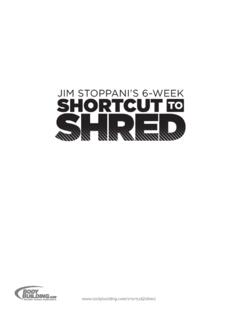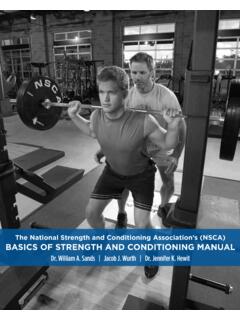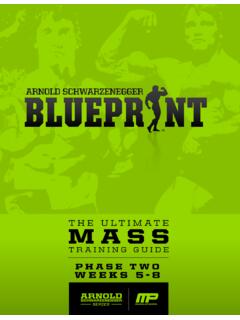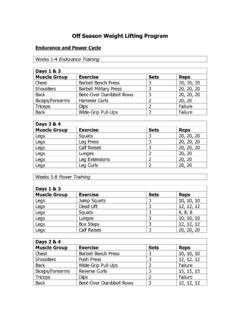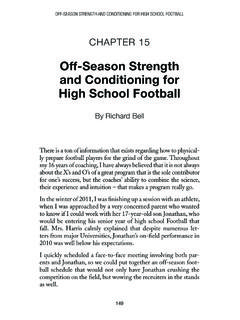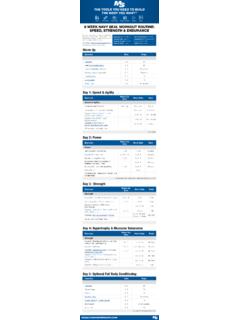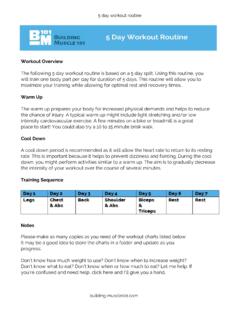Transcription of Incorporating an in-season basketball strength maintenance ...
1 Incorporating an in-season basketball strength maintenance program During the long basketball season, injuries and fatigue can affect a player s performance and the success of the entire team. To help prevent this from occurring, Dr. Steven Chudik, orthopaedic surgeon and sports medicine physician with the Sports Performance Institute at Hinsdale Orthopaedics and founder of the Sports Medicine Teaching/Research Foundation, recommends Incorporating an in-season program of low level plyometrics and strength exercises into basketball players schedules. Plyometrics have been shown to help athletes maintain their peak strength , power and performance. In the May 2008 Journal of strength and Conditioning Research, investigators reported that basketball players who participated in a two-day per week, in-season strength and plyometric program improved on four different performance measurements including their vertical jump.
2 An in-season strength maintenance program should be quick, efficient and timed appropriately. It requires some planning to properly schedule workouts around games and practice schedules and avoid training too close to a specific competition and negatively impacting performance. In season, schedule two days for full-body workouts at least 20- to 30-minutes in duration. Players should perform strength workouts after a game or practice and plyometric workouts before any conditioning because fatigue affects proper form. Ideally, players should have 48-hours rest between workouts and 48-hours rest between workouts and games. Precautions With any exercise program, it is very important to follow precautions and maintain proper form. This is especially important with plyometrics because they are impact exercises which may cause injury if done incorrectly. This most often occurs on landings if players don t come down softly on their toes and roll their weight to the heels.
3 Or, if a player twists the knees. To minimize injury, these safety precautions should be followed: Athletes should be well-conditioned with a high level of leg strength . Warm up thoroughly before starting if not done after a game or practice. Start slowly with small jumps and gradually build. (Continued on page 2) Winter 2011-2012 10 1 0 E xecu ti ve C our t Su it e 25 0 W est mo nt Il lin oi s 60 5 59 6 3 0-920-2 35 0 (Continued from page 1) Land softly to absorb the shock. Perform the exercises on cushioned surfaces and wear shoes with plenty of cushioning. Allow rest time between workouts. Stop immediately if there is any pain. maintenance Program Guidelines When using the in-season basketball strength maintenance program it is important athletes rest 48-hours between the first and second workout and rest 48-hours between workouts and a game.
4 Also, these workouts should be done after a game or practice, but before any conditioning so fatigue doesn t affect proper form and risk injury. During the season, plan for two days of full-body workouts that are 20-30 minutes in length. The purpose of a low repetition (rep) maintenance program is not to go until fatigue occurs, but to be just heavy enough to maintain absolute strength . So, start by finding that point, or approximately a 85 percent of your 1-rep max. This is done by first determining 100 percent of your 1-rep max. A safe approach to calculating this is by performing a 3-rep max and then use the formula below to get the estimated 100 percent of your 1-rep max . Warm Up Program Take the 3-rep max weight and multiply it by to get 100 percent of the 1 rep max. Athlete example: 3-rep max = 250 lbs. 250 lbs. x = 275 lbs. 1-rep max = 275 lbs.
5 275 lbs. x = 234 lbs (85% of 1-rep max) Exercise Sets Reps/Time Rest Between Sets % 1-Rep Max Jump Rope 2 1 minute 30 seconds Push-Ups 1 15 30 seconds Side Squats 1 5 per leg 30 seconds bent over Row 1 8 30 seconds 70 percent 2 maintenance Program The exercises below are to be followed based on the level of experience and age of each athlete. Perform the last three exercises for each workout in a circuit format one after the other, then repeat. All the others are done one at a time for the number of sets indicated. First Workout Second Workout Rep a *If the athlete can do more than 4 chin-ups, use ankle weights, a vest or hold a dumbbell between feet to increase difficulty. Exercise Sets Reps/Time Rest Between Sets % 1 Rep Max barbell Push Press 3 4 2 minutes 85 percent 1-Leg Lateral Hop 3 30 seconds 30 seconds Alternate 1-Leg Bound 3 30 seconds 30 seconds 2-to1 Leg 90-Degree Hop 2 60 seconds 30 seconds A Side Plank Leg Lift Repeat Circuit 2 Times 40-60 seconds No rest, continue to next cir-cuit exercise B Pull Down/Chin-Up* 4 *Add 10% of body weight C Side Lunge 5 each leg Rest 30 seconds after completing circuit Exercise Sets Reps/Time Rest Between Sets % 1 Rep Max High Pull from Hang 3 4 2 minutes 85 percent Split Jumps 3 30 seconds 30 seconds 2 -to 1- Leg Jump 3 30 seconds 30 seconds 180 Degree Jump 2 60 seconds 30 seconds A Plank Leg Lift Repeat Circuit 2 Times 40 seconds No rest.
6 Continue to next circuit exercise B Bench Press 4 85 percent C bent over Row 4 Rest 30 seconds after completing circuit 85 percent 3 High Pull From Hang 1. Adjust the weight to 85 percent of 1-rep max (see calculation on page 2). 2. Stand with your feet shoulder-width apart. Grab the bar in an overhand grip with your hands positioned just outside your knees. 3. With your back flat, raise the bar to just below your knees. Your shoulders should be over the bar with your arms straight and elbows facing out. Your weight should be in the heels with your knees slightly bent and hips pushed back. 4. Straighten your hips, knees and ankles while bringing the bar up in an explosive vertical pull. 5. Shrug your shoulders to bring the bar up to your chest. 6. Lower the bar and repeat. Sets Reps/ Time Weight Rest Mins/Secs 3 4 Reps 85% of 1-RM 2 minutes 4 Split Jump 1.
7 Start in a lunge position with your arms in a running form. 2. Jump straight up pushing off your front heel and back toe. 3. While in the air, switch legs so you land with the other foot forward. Remember to keep your chest up. 4. Bend the back knee as you land on the floor and explode back into the air landing with the other foot forward. Sets Reps/ Time Rest Mins/Secs 3 30 secs 30 secs 5 2-to1-Leg Jump 1. Start in a semi-squat position standing on both feet as shown. 2. Keep your arms at your sides and slightly behind your knees. 3. Begin to swing both arms forward and jump off both feet. 4. Land softly on one foot in the semi-squat position. 5. Repeat the exercise landing on the opposite foot. 6. Continue the exercise alternating landing legs to reach sets and repetitions above. Sets Reps/ Time Rest Mins/Secs 3 30 secs 30 secs 6 180-Degree Jump 1. Start in a semi-squat position standing on both feet as shown with your arms at your sides and slightly behind your knees.
8 2. From this position, jump up and rotate your body 180-degrees. Lead the rotation with your hips. 3. Land softly back in the semi-squat position. 4. Quickly jump back to the right and land softly returning your body to the original starting position. 5. Repeat alternating the turning direction right, then back to the left. Sets Reps/ Time Rest Mins/Secs 2 60 secs 30 secs 7 Circuit A Plank Leg Lift 1. Lie on your stomach with your elbows positioned directly under your shoulders. 2. Lift your hips off of the floor until they are even with your shoulders. 3. Tighten your butt (gluteus maximus) and abdominal (abs) muscles as you lift one foot off the floor. Remember to keep your back flat. 4. Hold for 40-seconds, then return your foot to the floor. 5. Repeat alternating legs. Sets Reps/ Time Rest Mins/Secs 3 40-60 secs No rest, continue to next circuit exercise 8 Circuit B Bench Press 1.
9 Adjust the weight to 85 percent of 1-rep max (see calculation on page 2). 2. With both feet on the floor, lie on your back with your head, shoulders and hips touching the bench. 3. Bend your arms at your elbows so they are at 90-degrees to your shoulders. 4. Place your hands on the bar directly above your elbows. 5. Put your ring fingers on the smooth loop to ensure proper arm spacing. 6. Lift the bar off the rack and lower it until your elbows are even with shoulders. Note: The bar may touch the chest only if elbows are even with shoulders. 7. Push the bar up evenly with both arms until they are straight. Stop, then lower and repeat. Sets Reps/ Time Weight Rest Mins/Secs 2 4 Reps 85% of 1-RM No rest, continue to next circuit exercise 9 Circuit C bent - over barbell Roll 1. Adjust the weight to 85 percent of 1-rep max (see calculation on page 2). 2. Stand with your feet shoulder-width apart.
10 3. Grab the bar with an underhand grip placing your hands just outside your knees. 4. Without arching your back, pull the bar up to your knees. 5. Squeeze your shoulder blades together as you continue to raise the bar. 6. Lower the bar to hip level to end the exercise. 7. Repeat as indicated above to reach desired sets and repetitions. Sets Reps/ Time Weight Rest Mins/Secs 2 4 Reps 85% of 1-RM Rest 30 seconds then repeat circuit 10 barbell Push Press 1. Adjust the weight to 85% of 1-rep max (see calculation on page 2). 2. Grasp barbell with both hands and stand with your feet shoulder-width apart. 3. Using proper posture, bring the bar to chest level. 4. Quickly push your hips back, bend your knees slightly and without pausing, explode vertically pushing the bar overhead as you rise on your toes. 5. Drop down on your heels as you straighten your arms. Push your head slightly in front of the bar as you reach back with your arms.
